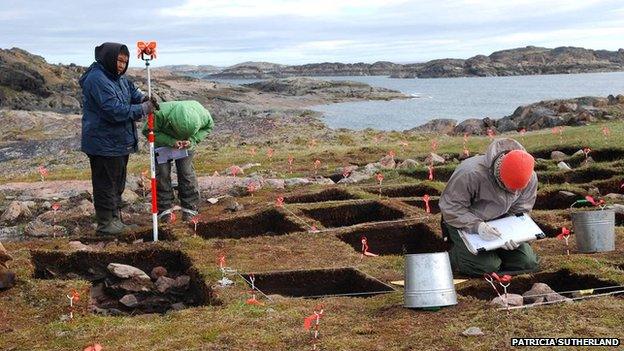The search for Canada's Vikings
- Published

An excavation at Cape Tanfield on mainland Canada
An archaeologist with close links to Scotland is painstakingly gathering evidence of early Viking contact with people who once occupied Arctic Canada.
Pat Sutherland has spent 13 years investigating artefacts recovered from Baffin Island and mainland Canada.
The items are similar to those made in Greenland and European Viking sites.
Dr Sutherland said they suggest close contact between the Norse and hunters known as the Dorset, who mysteriously disappeared in the 14th Century.
The Dorset culture occupied parts of Canada for 2,000 years before Inuit moved in from Alaska.
Dr Sutherland, a Canadian archaeologist, is an honorary research fellow at the University of Aberdeen.
Among the 15 collaborators in her work have been Mary MacLeod, a Western Isles-based archaeologist and University of the Highlands and Islands lecturer she became friends with after buying a house on the Isle of Lewis.
Ms MacLeod took part in an excavation of a site on Baffin Island in 2011.
'Isolated people'
Dr Sutherland's research features in the latest edition of the National Geographic magazine.
She told the BBC Scotland news website that she expects her project to involve a further five years of field work and analysis.
The archaeologist said: "The view of the Dorset culture had been that they were a very isolated people with very little contact with anyone.
"When the project began a new picture emerged of the Dorset culture."
Fresh examinations of material gathered during excavations in the 1960s and 70s, along with new finds, have questioned previous ideas about the Dorset.
Dr Sutherland said: "There are three groups of artefacts found over a 1,500km of coastline from north Baffin to northern Labrador from sites that were occupied by the Dorset people that suggest a Norse presence."
One group is cord spun from animal hair. Penelope Rogers, a York-based expert on Norse textiles from Greenland, studied the Canadian cordage and found that it was comparable to that found in Greenland.
Notched sticks used by the Vikings in trading goods, or as a calendar, make up a second group of artefacts.
The third is whetstones - used for sharpening weapons and tools - which have also been identified as being similar to those uncovered at European Viking sites.
Dr Sutherland said: "The latest work being done on the whetstones is to identify smelted metal traces on the surfaces."
The archaeologist said while no connections have been found between the Dorset sites and Norse that occupied parts of Scotland, Scottish collections of Viking artefacts - including those held in Shetland - had helped to form her knowledge of the Norse.
- Published19 August 2012
- Published23 January 2012
- Published19 October 2011
- Published5 May 2011